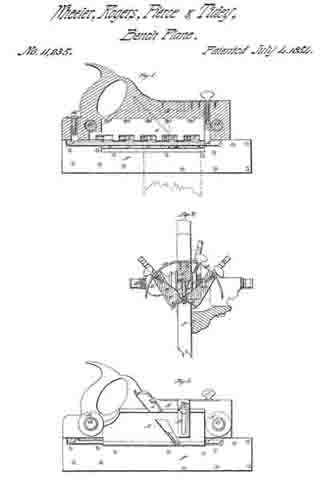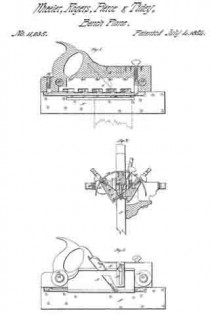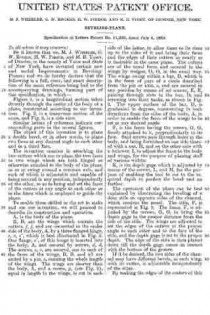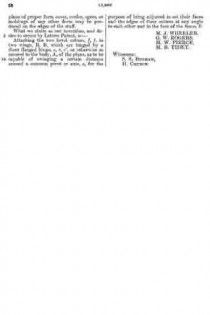No. 11,235 – Beveling Plane (Wheeler, Rogers, Pierce & Tidey) (1854)

UNITED STATES PATENT OFFICE.
_________________
M. J. WHEELER, G. W. ROGERS, H. W. PIERCE AND M. B. TIDEY, OF DUNDEE, NEW YORK.
BEVELING-PLANE.
_________________
Specification of Letters Patent No. 11,235, dated July 4, 1854.
_________________
To all whom it may concern:
Be it known that we, M. J. WHEELER, G. W. ROGERS, H. W. PIERCE, and M. B. TIDEY, of Dundee, in the county of Yates and State of New York, have invented certain new and useful Improvements in Beveling-Planes; and do not hereby declare that the following is a full, clear, and exact description of the same, reference being had to the accompanying drawings, forming part of the specification, in which–
Figure 1, is a longitudinal section taken directly through the center of the body of a plane, constructed according to our invention. Fig. 2, is a side view.
Similar letters of reference indicate corresponding parts in the several figures.
The object of this invention is to plane a double bevel, or in other words, to plane two faces at any desired angle to each other and to a third face.
The invention consists in attaching the two cutters which are to plane the two faces to two wings which are both hinged or otherwise attached to the body of the plane, so as to swing around a common axis, and each of which is adjustable and capable of being secured in any position, independently of the other, so as to bring and set the faces of the cutters at any angle to each other or to the fence which is employed to guide the plane.
To enable those skilled in the art to make and use our invention, we will proceed to describe its construction and operation.
A, is the body of the plane.
B, B, are the wings which contain the cutters, f, f, and are connected to the under side of the body, A, by a three flanged hinge, c, c, c’, which is best illustrated in Fig. 2. One flange, c’, of this hinge is inserted into the body, A, and secured by screws, d, d. The screws, c, c, are secured, one to each of the faces of the wings, B, B, and all are united by a pin, e, running the whole length of the wings. The wings are shorter than the body, A, and a recess, g, (see Fig. 2), equal in length to the wings, is cut in each side of the latter, to allow them to lie close up to the sides of it and bring their faces and the edges of their cutters as nearly as is desirable in the same plane. The cutters are of the usual form and secured in the wings by wedges, O, ), in the usual way. The wings swing within a bar, D, which is in the form of part of a circle described from the pin or axis, e, and are secured in any position by means of set screws, E, E, passing through slots in the bar, D, and screwing into their backs, as shown in Fig. 2. The upper surface of the bar, D, is graduated in degrees, commencing in both directions from the sides of the body, A, in order to enable the faces of the wings to be set at any desired angle.
F, is the fence having the screws, G, G, firmly attached to it, perpendicularly to its face. Said screws pass through holes in the body, and being furnished on one side thereof with a nut, H, and on the other side with a follower, I, to adjust the fence to the body and wings, for the purpose of planing stuff of various widths.
K, is the depth gage which is adjusted by means of the screws, L, and M, for the purpose of enabling the tool to cut to the required depth to perfect the bevel and no farther.
The operation of the plane can be best explained by illustrating the beveling of a door stile on opposite sides of the channel, which receives the panel. The stile, P, is represented in Fig. 2. The fence, F, is adjusted by the screws, G, G, to bring the depth gage to the proper distance from the side of the stile. The wings are adjusted to set the edges of the cutters at the proper angle to each other and to the face of the stile, and the depth gage is set to the proper depth. The edge of the stile is then planed down till the depth gage comes in contact with the bottom of the groove.
If it be desired, the two sides of the channel may have different bevels, as each wing, with its cutter, is adjustable independently of the other.
By making the edges of the cutters of this plane of proper form coves, ovolos, ogees, or moldings of any other form may be produced on the edges of the stuff.
What we claim as our invention, and desire to secure by Letters Patent, is:–
Attaching the two bevel cutters, f, f, to two wings, B, B, which are hinged by a three flanged hinge, c, c, c’, or otherwise so secured to the body, A, of the plane, as to be capable of swinging a certain distance around a common pivot or axis, e, for the purpose of being adjusted to set their faces and the edges of their cutters at any angle to each other and to the face of the fence, F.
M. J. WHEELER.
G. W. ROGERS.
H. W. PIERCE.
M. B. TIDEY.
Witnesses:
S. S. BENHAM,
H. CHURCH.



